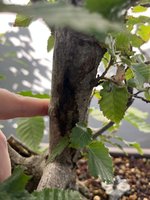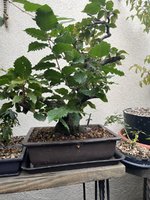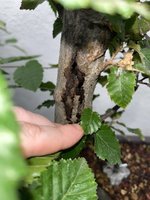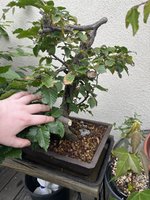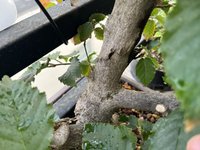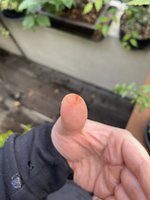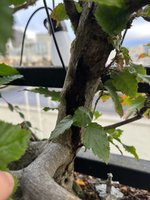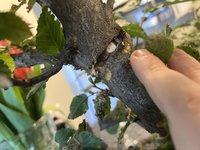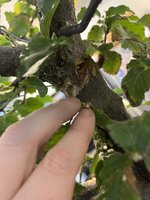You are using an out of date browser. It may not display this or other websites correctly.
You should upgrade or use an alternative browser.
You should upgrade or use an alternative browser.
Bacterial Wetwood in this K Hornbeam?
- Thread starter Scrogdor
- Start date
Deep Sea Diver
Imperial Masterpiece
Not sure. Is it possible to take a couple more photos including full tree that are well focused? …and add in the horticulture and conditions leading up to this situation.
Cheers
DSD sends
Cheers
DSD sends
Scrogdor
Chumono
Unsure of its life before a couple weeks ago. It’s a tree I just bought from a nursery in Sacramento. I haven’t done anything to itNot sure. Is it possible to take a couple more photos including full tree that are well focused? …and add in the horticulture and conditions leading up to this situation.
Cheers
DSD sends
Attachments
Last edited:
Deep Sea Diver
Imperial Masterpiece
Thanks!
Looks like a wound, or wood pecker smacked it.
Her’s a couple ideas.
Try spraying with 3% H2O2 and at the same time scrub the area with a toothbrush….(cover the media). Let it dry and see what this reveals.
If it’s sappy, use alcohol to remove it to find the source(s)
cheers
DSD sends
Looks like a wound, or wood pecker smacked it.
Her’s a couple ideas.
Try spraying with 3% H2O2 and at the same time scrub the area with a toothbrush….(cover the media). Let it dry and see what this reveals.
If it’s sappy, use alcohol to remove it to find the source(s)
cheers
DSD sends
Scrogdor
Chumono
Another thing i noticed is this 45 degree angle bulge with cracks just under the fissure. When I press on the bark around the fissure it’s soft. Was “oozing again” this morning. Color is like a dark brown that is coming out of it.
Attachments
0soyoung
Imperial Masterpiece
It may be diseased and require you to 'chop' the trunk to save the tree. But there won't be much left if that is the case.
I would start flaking off all the loose bark to see what is going on. When the cambium dies the cells rupture and release fluids. At this point the bark is usually 'gooey'. As this necrotic tissue desiccates, the bark will separate from the wood - one will perceive a hollow beneath that bark and eventually it cracks. When it is the result of simple mechanical damage, the cambium develops a new ectoderm and will tend to regrow over the exposed wood. If there is a pathogen, one will not find the regrowth 'lip' we are all so familiar with. If you don't, I suggest that you remove any abnormal tissue around the perimeter, then apply peroxide spray as @Deep Sea Diver advised and then cover the entire area with saran for the two or three weeks it takes for the cambium to develop a new ectoderm (alternatively, apply your favorite 'cut paste').
Of course, it is possible that you find the situation is not so simple and far more alarming. Removing all infected tissues is often the only way to cure tree maladies, meaning cut it off and throw it away or maybe even discard the entire thing to a good compost pile. Let's hope it is not this bad.
I would start flaking off all the loose bark to see what is going on. When the cambium dies the cells rupture and release fluids. At this point the bark is usually 'gooey'. As this necrotic tissue desiccates, the bark will separate from the wood - one will perceive a hollow beneath that bark and eventually it cracks. When it is the result of simple mechanical damage, the cambium develops a new ectoderm and will tend to regrow over the exposed wood. If there is a pathogen, one will not find the regrowth 'lip' we are all so familiar with. If you don't, I suggest that you remove any abnormal tissue around the perimeter, then apply peroxide spray as @Deep Sea Diver advised and then cover the entire area with saran for the two or three weeks it takes for the cambium to develop a new ectoderm (alternatively, apply your favorite 'cut paste').
Of course, it is possible that you find the situation is not so simple and far more alarming. Removing all infected tissues is often the only way to cure tree maladies, meaning cut it off and throw it away or maybe even discard the entire thing to a good compost pile. Let's hope it is not this bad.
Deep Sea Diver
Imperial Masterpiece
Spent a goodly amount of time researching this issue as Korean Hornbeams tend to be very hardy. Phytophthora ramorum first came up as a possible candidate. Yet that’s mainly an oak tree deal…
Later found a number of articles that mention various other species of Phytophthora affect both beeches and birches… and a hornbeam is in the birch family… there is a description remarkably similar to that which was described and shown in the photos above.
Phytophthora Bleeding Canker
Since this disease can girdle a tree some action should be considered. Some articles recommend cutting out the tissue and if there are definite margins, the disease is contained, yet if it’s spread into the cambium, that’s a different story and a trunk chop would be in order.
In any event agree with @Osoyoung, if it’s not localized a trunk chop might possibly contain the disease, but again the entire tree may need to be disposed of in worst case scenario.
Also this disease can spread to other trees by soil, water, tools and touch, not seeming by being near another tree.
So please be careful to disinfect all tools and hands… also properly dispose of any wood or debris cut off.
Regrets
DSD sends
Later found a number of articles that mention various other species of Phytophthora affect both beeches and birches… and a hornbeam is in the birch family… there is a description remarkably similar to that which was described and shown in the photos above.
Phytophthora Bleeding Canker
Since this disease can girdle a tree some action should be considered. Some articles recommend cutting out the tissue and if there are definite margins, the disease is contained, yet if it’s spread into the cambium, that’s a different story and a trunk chop would be in order.
In any event agree with @Osoyoung, if it’s not localized a trunk chop might possibly contain the disease, but again the entire tree may need to be disposed of in worst case scenario.
Also this disease can spread to other trees by soil, water, tools and touch, not seeming by being near another tree.
So please be careful to disinfect all tools and hands… also properly dispose of any wood or debris cut off.
Regrets
DSD sends
Last edited:
Scrogdor
Chumono
YikesIt may be diseased and require you to 'chop' the trunk to save the tree. But there won't be much left if that is the case.
I would start flaking off all the loose bark to see what is going on. When the cambium dies the cells rupture and release fluids. At this point the bark is usually 'gooey'. As this necrotic tissue desiccates, the bark will separate from the wood - one will perceive a hollow beneath that bark and eventually it cracks. When it is the result of simple mechanical damage, the cambium develops a new ectoderm and will tend to regrow over the exposed wood. If there is a pathogen, one will not find the regrowth 'lip' we are all so familiar with. If you don't, I suggest that you remove any abnormal tissue around the perimeter, then apply peroxide spray as @Deep Sea Diver advised and then cover the entire area with saran for the two or three weeks it takes for the cambium to develop a new ectoderm (alternatively, apply your favorite 'cut paste').
Of course, it is possible that you find the situation is not so simple and far more alarming. Removing all infected tissues is often the only way to cure tree maladies, meaning cut it off and throw it away or maybe even discard the entire thing to a good compost pile. Let's hope it is not this bad.
Scrogdor
Chumono
Well...... The situation is pretty dire, there is soft mush wood with black borders that spirals all the way up the tree to the apex. Just a large spiraling cavern of mush wood. It doesn't appear I'll just be able to cut away the infected tissue without losing a significant portion of the the main trunk.It may be diseased and require you to 'chop' the trunk to save the tree. But there won't be much left if that is the case.
I would start flaking off all the loose bark to see what is going on. When the cambium dies the cells rupture and release fluids. At this point the bark is usually 'gooey'. As this necrotic tissue desiccates, the bark will separate from the wood - one will perceive a hollow beneath that bark and eventually it cracks. When it is the result of simple mechanical damage, the cambium develops a new ectoderm and will tend to regrow over the exposed wood. If there is a pathogen, one will not find the regrowth 'lip' we are all so familiar with. If you don't, I suggest that you remove any abnormal tissue around the perimeter, then apply peroxide spray as @Deep Sea Diver advised and then cover the entire area with saran for the two or three weeks it takes for the cambium to develop a new ectoderm (alternatively, apply your favorite 'cut paste').
Of course, it is possible that you find the situation is not so simple and far more alarming. Removing all infected tissues is often the only way to cure tree maladies, meaning cut it off and throw it away or maybe even discard the entire thing to a good compost pile. Let's hope it is not this bad.
The good news, is that it appears the tree has walled off everything below that bulge.
Scrogdor
Chumono
Performed a chop, sprayed with peroxide, sealed the chop, also watered the soil of said tree and all surrounding trees with peroxide mix. Used peroxide/alcohol to clean all tools used. I guess what I learned is to investigate fissures in tree bark before I buy, even if they're small. Hopefully, I can salvage this tree. Wouldn't be surprised to see some serious dieback where that chop was made though. Better than it oozing more spores risking my other trees. I'll probably do the next few waterings with some peroxide, then again in the spring for this tree.
BobbyLane
Imperial Masterpiece
'Any event that occurs to the tree, as long as it doesnt kill it, is an opportunity for a design change' -Dan robinson
Scrogdor
Chumono
Forgot to take more pictures, but here are a couple that show basically what I was able to push a screw driver through under the cambium. I was attempting to Dremel the rot away until I realized it wrapped all the way around.
Attachments
Similar threads
- Replies
- 17
- Views
- 8K
- Replies
- 10
- Views
- 1K

